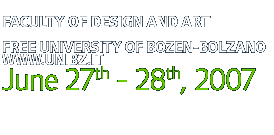

Home: Design Research | Speakers | Programme | Contact | Press | Links | Registration
technology transfer
How does technology transfer occur? How far is it affected by the culture of those who are involved in it? A sociological research on social variables influencing technology transfer performed through collaborative projects between public and private sector activities.
| :: More about the conference |
| :: Design Research –>Design –>Research –>Research Projects –>Project Index –>Abstract |
| :: Curators |
| :: Panel Chairs |
| Abstract: Under a research project financed by the MIUR (FIRB - Fund for Investing in Fundamental Research) in 2006/08 and carried out by the INFM (National Institute for the Physics of Matter) of Genoa and other institutions, this support research, conducted on behalf of and with the financial support of Sincrotrone Trieste, aims to verify and describe the social conditions in which technology transfer takes place when it is performed through collaborative projects between public and private sector activities. The starting hypothesis is that collaborative projects of the same type can lead to different results depending on the degree of cultural compatibility between the parties concerned. In collaborative projects, scientific and industrial cultures often come into direct contact, facing decisions and dealing with procedures, and probably experiencing difficulties of integration. Such sociocultural phenomenon can influence the result of the collaborative project, and can decide which types of collaboration are more promising and which are less so, regardless of economic or legal considerations. Through 4 case studies, the research endeavours to understand whether and in what way the cultural heritage of the people involved in the technology transfer affect the success or failure of the enterprise. Author: Paolo Volonté (I) | Associate Professor (FUB) Thematic area: Sociology –>back www.unibz.it paolo.volonte@unibz.it |